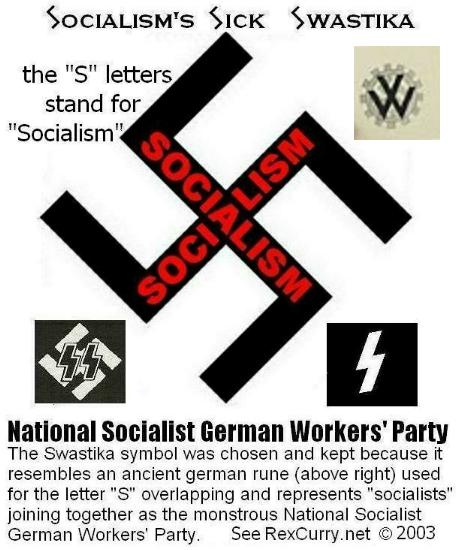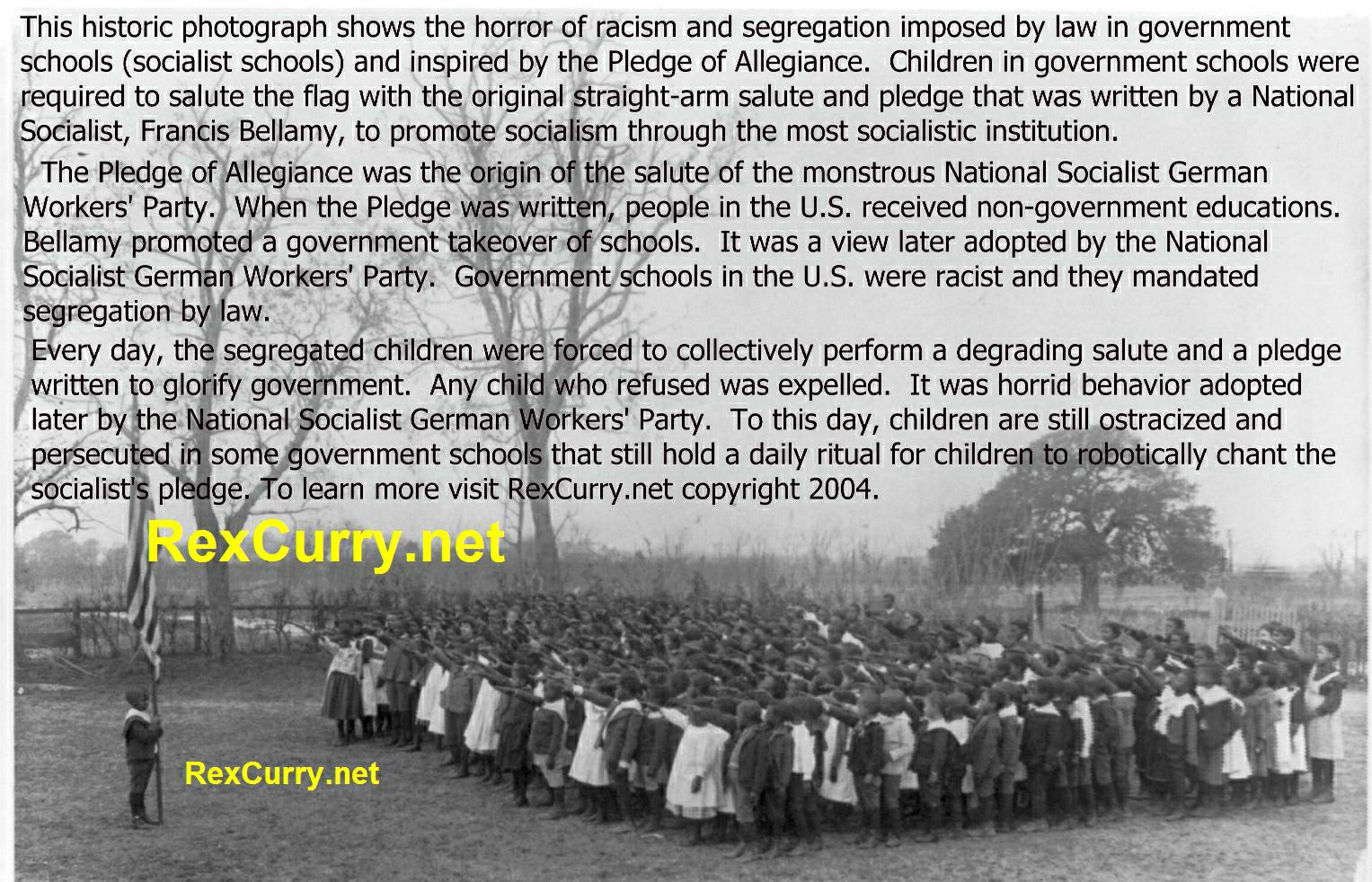SWASTIKA MYTH EXPOSED BY ADOLF HITLER'S OWN WORDS IN THE
BOOK MEIN KAMPF ETC & SUPPORTS CRYPTOLOGIST DR. REX
CURRY's DISCOVERIES ABOUT SWASTIKAS
Image at http://rexcurry.net/fascism-third-reich-hitler-nazism-swastika456.jpg
Francis Bellamy, Edward Bellamy, Looking Backward, Pledge of Allegiance, Military salutes
Cryptologist and Symbologist Dr. Rex Curry http://rexcurry.net/rex-curry.jpg =>
Cryptologist image http://rexcurry.net/fascism-third-reich-hitler-nazism-swastika456.jpg

Around November 7, 1935, the war (or military) flag was announced under German National Socialism. "Soldiers of the armed forces, " Adolf Hitler said "The swastika cross shall be for you a symbol of the nation's unity and purity, an emblem of the National Socialist Weltanschuung [world view] and a pledge for the Reich's freedom and strength." (see the book "The Swastika - Symbol beyond redemption?" by Steven Heller).
In Mein Kampf, the German socialist leader referred to the socialist swastika and the flag: "In red we see the social idea of the movement, in white the nationalistic idea, in the swastika the mission of the struggle for the victory of the Aryan man, and, by the same token, the victory of the idea of creative work..." (pg. 496-497). In German the swastika reference was: "im Hakenkreuz die Mission des Kampfes für den Sieg des arischen Menschen und zugleich mit ihm auch den Sieg des Gedankens der schaffenden Arbeit,"
In his own words, Hitler stated that the swastika referred to work (labor) and mimicked Soviet socialism's "new" swastika replacement, the Hammer and Sickle (two tools of workers). Hitler states that the Hakenkreuz (hooked cross) represents two crossed "S" shapes known as "sieg" symbols. Those "S" letters were used for "S" in other German socialist symbolism. He made overlapping use of the word "victory" or "sieg" in German. The red color and the "social idea of the movement" ties into socialism for which Hitler claimed the National Socialist German Workers' Party was struggling for victory. The so-called "swastika" represented two "S" letters for "socialism" and is related to "Sieg Heil!" in the sense of the NSGWP's cry of "Hail to the Victory of Socialism!" His use of the term "arischen" mimicks the Soviet swastika and the Soviet hammer and sickle in the effort to glorify workers (represented by their tools in the hammer and sickle) as the new super soviet socialist men.
http://rexcurry.net/george-bernard-shaw-superman-socialist-swastika-socialism.html
German socialists were heavily influenced by earlier Soviet socialists, even in regard to concentration camps, purges, and genocide.
In 1939, the Union of Soviet Socialist Republics and the National Socialist German Workers’ Party joined as allies to invade Poland in a Pact to divide up Europe, spreading WWII. http://rexcurry.net/socialists.html
They USSR embraced the swastika symbol even more then, and the hammer and sickle was displayed proudly next to and in partnership with the socialist swastika.
Hitler also wrote: "Two years later, when our squad of hall guards had long since grown into storm detachments, it seemed necessary to give this defensive organization of a young Weltanschhauung a particular symbol of victory, namely a Standard." In German it was: "Zwei Jahre später, als aus der Ordnertruppe schon längst eine viel tausend Mann umfassende Sturmabteilung geworden war, schien es nötig, dieser Wehrorganisation der jungen Weltanschauung noch ein besonderes Symbol des Sieges zu geben: die Standarte." In the only comments on the swastika by Hitler, the Sturmabteilung was specifically referenced. The Sturmabteilung had a well-known Nazi banner that included the swastika and another banner also utilizing another stylized "S" symbol.
Socialists socialized the swastika in more ways than one. On May, 19, 1933, Josef Goebbels' announced the "Law for Protection of National Symbols." The anti-capitalist attitude of the socialists banned use of the swastika for individual or commercial purposes. The swastika was socialized for official purposes for the glory and worship of government.
Germany's socialist swastika had the same meaning as the earlier Soviet Swastika and the Hammer and Sickle: The German and Soviet swastikas were two "S" letters that represented socialists joining together; the hammer and sickle represented socialists joining together, particularly workers joining with peasants, or factory workers joining with agricultural workers. http://rexcurry.net/ussr-socialist-swastika-cccp-sssr.html
The German term for "swastika" is "Hakenkreuz" ("hooked cross") because the symbol represented two separate pieces crossed (two "S" shaped pieces).
Hitler never referred to the swastika as an ancient good-luck swastika symbol, nor let on that he even possessed such knowledge. The symbol is never even referred to as a "swastika" but as a "Hakenkreuz" (hooked cross). Socialists have covered-up for the National Socialist German Workers' Party by always using the term "swastika" when discussing a symbol that was always referred to as a "hakenkreuz" by National Socialists. The misleading term "swastika" created the myth that National Socialists used the symbol because it was an ancient symbol for good luck.
In 1920, Hitler decided that the National Socialist German Workers' Party needed its own insignia. For Hitler, the new flag had to be "a symbol of our own struggle" as well as "highly effective as a poster." (Mein Kampf, Chapter 7 of the 2nd volume, sometimes pg. 495). On August 7, 1920, at the Salzburg Congress, this flag became the official emblem of the horrid party.
********************
In Mein Kampf, Hitler described the new flag: "In red we see the social idea of the movement, in white the nationalistic idea, in the swastika the mission of the struggle for the victory of the Aryan man, and, by the same token, the victory of the idea of creative work..." (pg. 496-497). In German the swastika reference was: "im Hakenkreuz die Mission des Kampfes für den Sieg des arischen Menschen und zugleich mit ihm auch den Sieg des Gedankens der schaffenden Arbeit,"
In his own words, Hitler is stating that the swastika is a "sieg" symbol that corresponds with the letter "S" and was used for "S" in other symbolism and he makes overlapping use of the word "victory" or "sieg" in German. The red color and the "social idea of the movement" ties into socialism for which Hitler claimed the National Socialist German Workers' Party was struggling for victory. The so-called "swastika" represented two "S" letters for "socialism" and is related to "Sieg Heil!" in the sense of "Hail to the Victory of Socialism!"
Hitler also wrote: "Two years later, when our squad of hall guards had long since grown into storm detachments, it seemed necessary to give this defensive organization of a young Weltanschhauung a particular symbol of victory, namely a Standard." In German it was: "Zwei Jahre später, als aus der Ordnertruppe schon längst eine viel tausend Mann umfassende Sturmabteilung geworden war, schien es nötig, dieser Wehrorganisation der jungen Weltanschauung noch ein besonderes Symbol des Sieges zu geben: die Standarte." In the only comments on the swastika by Hitler, the Sturmabteilung was specifically referenced. The Sturmabteilung had a well-known Nazi banner that included the swastika and another banner also utilizing another stylized "S" symbol.
Image at http://rexcurry.net/fascism-third-reich-hitler-nazism-swastika456.jpg
Francis Bellamy, Edward Bellamy, Looking Backward, Pledge of Allegiance, Military salutes
Cryptologist and Symbologist Dr. Rex Curry http://rexcurry.net/rex-curry.jpg =>

|
Saying the
Pledge of Allegiance in
images at http://rexcurry.net/book1a1contents-pledge.html
For fascinating information about symbolism see http://rexcurry.net/book1a1contents-swastika.html Hear audio on worldwide radio at http://rexcurry.net/audio-rex-curry-podcast-radio.html Fan Mail http://rexcurry.net/pledge_heart.html |
Cryptologist image http://rexcurry.net/fascism-third-reich-hitler-nazism-swastika456.jpg

Around November 7, 1935, the war (or military) flag was announced under German National Socialism. "Soldiers of the armed forces, " Adolf Hitler said "The swastika cross shall be for you a symbol of the nation's unity and purity, an emblem of the National Socialist Weltanschuung [world view] and a pledge for the Reich's freedom and strength." (see the book "The Swastika - Symbol beyond redemption?" by Steven Heller).
In Mein Kampf, the German socialist leader referred to the socialist swastika and the flag: "In red we see the social idea of the movement, in white the nationalistic idea, in the swastika the mission of the struggle for the victory of the Aryan man, and, by the same token, the victory of the idea of creative work..." (pg. 496-497). In German the swastika reference was: "im Hakenkreuz die Mission des Kampfes für den Sieg des arischen Menschen und zugleich mit ihm auch den Sieg des Gedankens der schaffenden Arbeit,"
In his own words, Hitler stated that the swastika referred to work (labor) and mimicked Soviet socialism's "new" swastika replacement, the Hammer and Sickle (two tools of workers). Hitler states that the Hakenkreuz (hooked cross) represents two crossed "S" shapes known as "sieg" symbols. Those "S" letters were used for "S" in other German socialist symbolism. He made overlapping use of the word "victory" or "sieg" in German. The red color and the "social idea of the movement" ties into socialism for which Hitler claimed the National Socialist German Workers' Party was struggling for victory. The so-called "swastika" represented two "S" letters for "socialism" and is related to "Sieg Heil!" in the sense of the NSGWP's cry of "Hail to the Victory of Socialism!" His use of the term "arischen" mimicks the Soviet swastika and the Soviet hammer and sickle in the effort to glorify workers (represented by their tools in the hammer and sickle) as the new super soviet socialist men.
http://rexcurry.net/george-bernard-shaw-superman-socialist-swastika-socialism.html
German socialists were heavily influenced by earlier Soviet socialists, even in regard to concentration camps, purges, and genocide.
In 1939, the Union of Soviet Socialist Republics and the National Socialist German Workers’ Party joined as allies to invade Poland in a Pact to divide up Europe, spreading WWII. http://rexcurry.net/socialists.html
They USSR embraced the swastika symbol even more then, and the hammer and sickle was displayed proudly next to and in partnership with the socialist swastika.
Hitler also wrote: "Two years later, when our squad of hall guards had long since grown into storm detachments, it seemed necessary to give this defensive organization of a young Weltanschhauung a particular symbol of victory, namely a Standard." In German it was: "Zwei Jahre später, als aus der Ordnertruppe schon längst eine viel tausend Mann umfassende Sturmabteilung geworden war, schien es nötig, dieser Wehrorganisation der jungen Weltanschauung noch ein besonderes Symbol des Sieges zu geben: die Standarte." In the only comments on the swastika by Hitler, the Sturmabteilung was specifically referenced. The Sturmabteilung had a well-known Nazi banner that included the swastika and another banner also utilizing another stylized "S" symbol.
Socialists socialized the swastika in more ways than one. On May, 19, 1933, Josef Goebbels' announced the "Law for Protection of National Symbols." The anti-capitalist attitude of the socialists banned use of the swastika for individual or commercial purposes. The swastika was socialized for official purposes for the glory and worship of government.
Germany's socialist swastika had the same meaning as the earlier Soviet Swastika and the Hammer and Sickle: The German and Soviet swastikas were two "S" letters that represented socialists joining together; the hammer and sickle represented socialists joining together, particularly workers joining with peasants, or factory workers joining with agricultural workers. http://rexcurry.net/ussr-socialist-swastika-cccp-sssr.html
The German term for "swastika" is "Hakenkreuz" ("hooked cross") because the symbol represented two separate pieces crossed (two "S" shaped pieces).
Hitler never referred to the swastika as an ancient good-luck swastika symbol, nor let on that he even possessed such knowledge. The symbol is never even referred to as a "swastika" but as a "Hakenkreuz" (hooked cross). Socialists have covered-up for the National Socialist German Workers' Party by always using the term "swastika" when discussing a symbol that was always referred to as a "hakenkreuz" by National Socialists. The misleading term "swastika" created the myth that National Socialists used the symbol because it was an ancient symbol for good luck.
In 1920, Hitler decided that the National Socialist German Workers' Party needed its own insignia. For Hitler, the new flag had to be "a symbol of our own struggle" as well as "highly effective as a poster." (Mein Kampf, Chapter 7 of the 2nd volume, sometimes pg. 495). On August 7, 1920, at the Salzburg Congress, this flag became the official emblem of the horrid party.
********************
In Mein Kampf, Hitler described the new flag: "In red we see the social idea of the movement, in white the nationalistic idea, in the swastika the mission of the struggle for the victory of the Aryan man, and, by the same token, the victory of the idea of creative work..." (pg. 496-497). In German the swastika reference was: "im Hakenkreuz die Mission des Kampfes für den Sieg des arischen Menschen und zugleich mit ihm auch den Sieg des Gedankens der schaffenden Arbeit,"
In his own words, Hitler is stating that the swastika is a "sieg" symbol that corresponds with the letter "S" and was used for "S" in other symbolism and he makes overlapping use of the word "victory" or "sieg" in German. The red color and the "social idea of the movement" ties into socialism for which Hitler claimed the National Socialist German Workers' Party was struggling for victory. The so-called "swastika" represented two "S" letters for "socialism" and is related to "Sieg Heil!" in the sense of "Hail to the Victory of Socialism!"
Hitler also wrote: "Two years later, when our squad of hall guards had long since grown into storm detachments, it seemed necessary to give this defensive organization of a young Weltanschhauung a particular symbol of victory, namely a Standard." In German it was: "Zwei Jahre später, als aus der Ordnertruppe schon längst eine viel tausend Mann umfassende Sturmabteilung geworden war, schien es nötig, dieser Wehrorganisation der jungen Weltanschauung noch ein besonderes Symbol des Sieges zu geben: die Standarte." In the only comments on the swastika by Hitler, the Sturmabteilung was specifically referenced. The Sturmabteilung had a well-known Nazi banner that included the swastika and another banner also utilizing another stylized "S" symbol.

